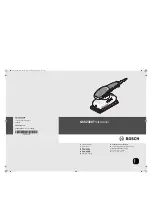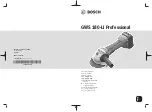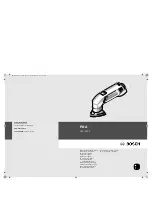
5
AIR BELT SANDER
EN
Translation of the original instructions
WARNING - SAFETY RULES
GENERAL INSTRUCTIONS
These instructions must be read and understood before any operation.
Any modification or update that is not specified in the instructions manual should not be undertaken.
The manufacturer is not liable for any injury or damage due to a non-compliance with the instructions contained in this manual.
If unsure of what to do, please ask a qualified person to handle the installation.
POSSIBLE RISKS IN RELATION TO POWER SUPPLY AND CONNECTIONS
• Pressurised air can cause serious damage.
• Always stop the air flow and disconnect the tool from the line to replace the accessories, repair it or if you are not using it.
• Do not direct the air flow at other people or yourself; always use the tool at a safe distance from people near the work area.
• Fast moving pipes can cause serious damage; check pipes and connections carefully for loss or breakage.
• Do not use the quick-change connections on the tool, they could weigh it down and loosen due to vibration.
• Read the instructions for correct assembly.
• Do not exceed the maximum air pressure limit of 6-7 bar or the value indicated on the plate of the pneumatic tool.
• Handle hoses and connectors with care. Do not use the hose to carry the machine. Do not use excessive force to pull the air connector out. Keep
hoses away from heat sources, lubricants and sharp edges.
• Check the hoses for wear before use. Check that all connections are secure.
RISKS CAUSED BY FRAGMENTS
• Always use eye and face protection equipment when using the tool.
• Smaller fragments could also cause eye damage and possibly blindness.
• The explosion of pneumatic tools can cause serious damage.
AVOID BECOMING ENTANGLED
• Keep a suitable distance from working drills, blades, moving tools, etc.
• Do not wear loose fitting clothing or jewellery and avoid long hair.
RISKS CAUSED BY OPERATION
• Wear protective gloves.
• Do not modify the tool or its accessories.
• Operators and maintenance personnel must be physically able to handle the power of the tool and follow the necessary procedures.
• Do not force the tool; if you use it at the speed for which it was designed, its performance will be better and more reliable.
• Correct assembly of the belt is necessary to avoid injuries caused by loose belts.
• Do not use chipped or cracked abrasive belts.
• Use only belts that are easily adapted to the machine. If you need more force than usual to install the tape, the size may be different from the one
required.
• Before sanding, test the belt by briefly turning the tool to full speed. Be sure to use a barrier (under a heavy work table, for example) to stop loose
belts.
• A cracked sanding belt will cause serious injuries!
• Check the speed of the unit regularly with a tachometer to ensure that the speed has not been exceeded and is consistent with the abrasive belts
you are using. The appropriate speed is indicated on the data sheet provided with the belts.
• Never use a belt whose speed is lower than that of this tool!
• Only used abrasive belts with the appropriate diameter, dimensions and speed, in accordance with the technical specifications of the tool.
• This tool has been developed as a belt sander and should only be used for this function. Any misuse can lead to serious health issues.
DANGERS CAUSED BY WORKING CONDITIONS
• Slipping, tripping and falling are the main causes of accidents.
• The high noise level can cause permanent damage to hearing. Employers and trade safety organisations recommend the use of earmuffs.
• Keep your body in balance and firmly on your feet. Repetitive work movements, unusual positions and exposure to vibration can be harmful to your
hands and arms. In case of numbness, tingling, pain or face getting pale, stop using the tool and consult a doctor.
• This tool is not suitable for use in hazardous areas.
SAFETY STANDARDS REGARDING THE USE OF THE TOOL
• Handle the belt sander with care to ensure long-lasting performance.
• Wear eye and ear protection, a half mask and protective gloves when using the tool.
• Use only in ventilated areas.
• Do not use the tool in hazardous areas and use it away from combustible materials; the contact between the tool and metals produces sparks.
• Do not hold the device by the hose.
• Abrasives heat up during use. Allow them to cool down before touching them. Disconnect the air hose when changing or adjusting the abrasives.
• Do not leave the pneumatic tool running when it is being transported.
• Switch off the unit immediately in case of blockage or twisting. Disconnect the air supply and do not turn on again until the problem is solved.
Understand the reason why the tool was blocked and make sure that this situation does not reoccur.
• Make sure that the accessory you want to use is not damaged. Replace the part if unsure.
• If the pneumatic tool emits a strong vibration, replace the accessory / abrasive material, probably damaged or worn out.






































